Thoroughly analyzing TS Inter 2nd Year Commerce Model Papers and TS Inter 2nd Year Commerce Question Paper May 2018 helps students identify their strengths and weaknesses.
TS Inter 2nd Year Commerce Question Paper May 2018 with Solutions
Time: 3 Hours
Maximum Marks: 100
Part – I (50 Marks)
Section – A
(2 × 10 = 20)
Note: Answer any TWO of the following questions not exceeding 40 lines each.
Question 1.
What are the differences between the Money Market and the Capital Market?
Answer:
Introduction:
Money Market: The center for dealing mainly of a short-term character, in monetary assets, it meets the short-term requirements of funds.
Capital Market: It is the market where long-term finance is provided to business firms through the sale of securities.
Differences:
| Concept | Money Market | Capital Market |
| 1. Nature | It deals with short-term credit instruments not exceeding one year. | It deals with long-term finance for more than one year. |
| 2. Components | The major players are commercial Banks, RBI, LIC, GIC UTI, etc. | The major players are merchant financial institutions, foreign investors, and individuals. |
| 3. Dealing Formation | It deals with credit instruments like Treasury bills, Commercial papers, Call money, etc. | It deals with shares, debentures, bonds, and Government securities. |
Question 2.
Define Banking and explain the functions of Banking.
Answer:
Bank is derived from the French word “Banco” which means a Bench. It is believed that the early bankers, the Jews of Lombardy transacted their business on benches in the marketplace.
Definition: “Banking is defined as accepting for lending or investment, of deposits of money from the public, repayable on demand or otherwise and withdrawable by cheque, draft, order of otherwise”. – Banking Regulation Act 1949 – Section 5 (1) (b).
Functions of Banks:
The core functions of a bank are
- Acceptance of money deposits from the public.
- Lending (or) making advances to the public.
- Undertaking Agency Services.
- Rendering General Utility Services.
1. Acceptance of Deposits:
Banks accept money from the public in various forms which constitute borrowings by banks. The deposits are one of the main sources of funds for the banks.
2. Lending (or) making advances to the public:
Banks lending the deposit amounts. It is a profit motive. The bank will not lend the whole of the deposits it keeps a certain amount to meet contingencies and the remaining portion is lent to the business community at a higher rate of interest. The difference between the rate of interest allowed and deposits and the rate charged on the loans is called as ‘spread’, it is the main source of income for a bank. An advance is a credit facility provided by a bank to its customers. It is generated for shorter periods. Further, the purpose behind granting an advance is to meet the day-to-day requirements of a business.
3. Agency Functions or Services:
Banks perform these functions for their customers. These are:
- To collect or pay bills, cheques, interest, dividends, rent, etc., on behalf of customers.
- For rendering these services, banks collect charges from their customers.
- To act as executor, trustee, and attorney on the customer’s will.
- To work as a correspondent, agent, or representative of their clients.
4. General Utility Services:
These services are provided to the general public. These are
- A letter of credit may be issued by the bank at the request of the importer to the exporter.
- Bank drafts and traveler’s cheques are issued to provide facilities for fund transfer from one part of the country to another part.
- Acceptance or collection of foreign bills of exchange.
- Banks arrange safe deposit lockers for the safe custody of customers’ securities, valuables, and jewelry.
- Other general public utility services.
![]()
Question 3.
What are the principles of Management?
Answer:
Generally, management has been defined as “getting things done through others”.
Definitions:
Management is a multipurpose organ that manages a business and manages managers and manages workers and work. – Peter F. Drucker.
Management is the art of knowing what you want to do and then seeing that it is done in the best and cheapest way”. – F.W. Taylor.
‘To manage is to forecast and to plan, to organize, to command, to co-ordinate and to control”. – Henry Fayol.
It has been observed that management is used as a collective noun to refer to all those who manage within a particular organization including those who help line managers by performing a staff function. ‘Henry Fayol’ has been rightly called the “Father of administrative management” for his practical approach to management theory. He has identified 14 fundamental principles of management. those are:
- Division of labour and specialization.
- Priority of authority and responsibility.
- Discipline.
- Unity of command.
- Unity of direction.
- Subordination of individual to general interest.
- Remuneration of personnel.
- Centralization.
- Scalar chain.
- Order.
- Equity.
- Stability of tenure of personnel.
- Initiative.
- Esperit-de-corps.
1. Division of Labour and Specialisation:
Division of labour leads to specialization which increases the efficiency of individual employees. Division of labour is a famous principle of economics. Fayol applied this principle to management. He recommended work of all kinds must be subdivided and allocated to several persons. Subdivision makes each task simpler and results in greater efficiency.
2. Priority of Authority and Responsibility:
According to Fayol, authority and responsibility must flow in the same direction. Responsibility is the natural outcome of authority. A proper balance between authority and responsibility helps to prevent the misuse of authority and promotes a fair fixation of responsibility.
3. Discipline:
Discipline means the observation of certain rules and regulations. People in the organization should be bound to accent certain codes of conduct. The three basic requisites of discipline are disciplined supervisors at all levels, clear and fair agreement on goals, and judicious application of penalties.
4. Unity of Command:
The principle states that a subordinate should receive orders and be accountable to only the superior. No employee, therefore, should receive instructions from more than one person. The principle is necessary to avoid confusion and conflict.
5. Unity of Direction:
Unity of direction is essential for achieving unity in action, in the pursuit of common goals by a group of persons. (one head, one plan) is not the same as unity of command (one employee receives orders from one superior).
6. Subordination of individual interest to general interest:
According to this principle, the fulfillment of individual objectives, in the long run, is contingent upon the attainment of common objectives is contingent upon the attainment of common objectives in the short run. Thus, in case the need arises, an individual must sacrifice in favor of larger group objectives.
7. Remuneration of Personnel:
Remuneration is the price paid to the personnel for the services rendered by them. According to Fayol, the system of remuneration personnel should be fair and satisfactory to both the employees and the employer. It should be attractive to employ and retain the best personnel.
8. Centralization:
It refers to the extent to which authority is concentrated or dispersed. The appropriate degree of centralization will vary with different concerns. It is a problem of finding the measure that will give the best overall yield. Under centralization managers or executives play an important role.
9. Scalar Chain:
It refers to the line of authority from the highest to the lowest executive for communication. However, in the routine course of business, employees at the same level can communicate with each other following the principle of ‘Gangplank’.
10. Order:
Fayol has classified order into two categories.
- Material Order: Material order is described as a place for everything and everything in its place.
- Social Order: Social order demands the employment of a “right man in the right place”.
11. Equity:
Equity is a combination of kindliness and justice. It seeks to elicit loyalty and devotion from personnel. Managers should show kindness and justice in dealing with their subordinates.
12. Stability of tenure of personnel:
High turnover increases inefficiency. An employee needs time to adjust to the new work, and its environment and demonstrate efficiency. Therefore, stability of tenure is a desirable principle for ensuring efficiency. Unnecessary employee turnover is the cause and effect of bad management.
13. Initiative:
The initiative is the freedom to propose and execute a plan. To have freedom in this respect is the greatest satisfaction for an intelligent person. A manager, who induces his subordinates to think and act on their own, is always better and more successful than the one who does not.
14. Esperit-de-corps:
It is a French phrase which means “Union is Strength.” It means the union is strong. There should be loyalty and concern for the honor of the organization to which one belongs. This can be achieved through the adoption of the principle of unity of command.
Section – B
(4 × 5 = 20)
Note: Answer any FOUR of the following questions not exceeding 20 lines each.
Question 4.
What do you mean by Bulls and Bears?
Answer:
Bull:
A Bull or Tejawalla is an operator who expects a rise in the prices of securities in the future. In anticipation of a price rise, he makes purchases of shares and debentures to sell at higher prices in the future. He being a speculator has no intention of taking delivery of securities but deals only in difference of prices. Such a speculator is called ‘Bull’ because of the resemblance of his behavior to a bull. A bull tends to throw his victims up in the air. Similarly, a bull speculator tries to raise the prices of securities by placing big purchase orders.
Bears:
Bear or Mandiwala speculators expect prices to fall in the future and sell securities at present to purchase them at lower prices in the future. A bear does not have securities at present but sells them at higher prices in anticipation that he will supply them by purchasing at present but sells them at higher prices in anticipation that he will supply them by purchasing at lower prices in the future. If the prices move down as per expectations of the bear. He will earn profits out of these transactions. A bear does not take the delivery of securities but takes the difference if prices fall, case the prices are not falling as expected by the bears then they may start speculator rumors to pressurize prices downwards, it is as the bear said.
![]()
Question 5.
Write any five principles of Insurance.
Answer:
It is the provision that a prudent man makes against forward happenings that may occur by chance and are carried out through the transfer of risks of many individuals to one person or a group of persons.
Principles:
- Utmost good faith: The contracts of insurance are included in the category of contracts. Those contracts require absolute and utmost faith on the part of the parties concerned.
- Insurable interest: No person can enter into a valid contract of insurance unless he has an insurable interest in the object. Essentially speaking, insurable interest is like financial interest in a life or things.
- Indemnity: All contracts of insurance, except for life insurance contracts, are contracts of indemnity. The principle of indemnity does not apply to life and other kinds of personal insurance. In such cases, the loss caused by the death of a person cannot be calculated in terms of money, nor is money any compensation for loss of life.
- Subrogation: According to if the insurer steps into the shoes of the insured and becomes entitled to all rights of the insured regarding the subject matter of insurance after the claim of the insured has been fully settled.
- Contribution: In such cases, the companies concerned will follow the principle of contribution. Each company will contribute that proportion of the loss that the policy issued bears to the total amount for which insurance has been effected with all the companies.
Question 6.
Differentiate Entrepreneur and Entrepreneurship.
Answer:
| Entrepreneur | Entrepreneurship |
| 1. He is a person. | 1. It is a plan of action. |
| 2. He is an administrator. | 2. It is an administration. |
| 3. He is a risk bearer. | 3. It is a risk-bearing activity. |
| 4. He is an innovator. | 4. It is a process of innovation. |
| 5. He combines factors of production. | 5. It is the process of use of factors of production. |
| 6. He is an initiator. | 6. It is taking an initiative. |
| 7. He is a leader. | 7. It is nothing but leadership. |
Question 7.
Explain the special provisions enacted by the Telangana State for the MSMEs.
Answer:
The special provisions for the micro, small, and medium enterprises (MSMEs) are as follows:
- An adequate number of smaller plots in industrial parks for SMEs and developed sheds.
- Special funds for addressing incipient sickness.
- Special fund for IP registration assistance.
- Special fund for anti-pirating assistance.
- Special fund for technology transfer and modernization of the MSME sector.
- Reimbursement of land conversion charges for units in own land.
- Marketing assistance to participate in national.
- Consultant panel to respond to MSME entrepreneur needs.
- Separate state-level bankers committee for industries.
Question 8.
Distinguish between Home Trade and Foreign Trade.
Answer:
| Home Trade | Foreign Trade |
| 1. Refers to the trade within the country. | 1. Refers to trade with other countries. |
| 2. There will be no restrictions. | 2. Subjected to many restrictions. |
| 3. Does not involve any exchange of currencies. | 3. Involves the exchange of currencies. |
| 4. There is scope for the operation of demand and supply forces. | 4. The scope for the operation of demand and supply forces is restricted. |
| 5. Transport costs and risks are less. | 5. Transport costs one more and risks are many. |
| 6. It facilitates the movement of goods from points of production to areas where they are consumed in the home country. | 6. It facilitates countries to specialize in manufacturing a particular line of products which enables them to sell those products across the globe. |
| 7. It helps to derive the benefits of specialization within the country. | 7. It helps all trading countries derive the benefits of specialization. |
| 8. The movement of goods depends upon the development of an internal transport system, especially road and rail. | 8. The movement of goods usually by road, rail, air, and water transport. |
| 9. The volume of trade depends upon the size of the population volume of production, the development of banking, and other supporting facilities. | 9. There are restrictions imposed on the size of the population volume of free entry of goods and duties and production, and development of banking taxes are to be paid. The volume of and other supporting facilities. Trade depends on this factor. |
Question 9.
Explain the Principles of Directing.
Answer:
The principles are explained below.
1. Maximum Individual Contribution:
This principle emphasizes that directing techniques must help every individual in the organization contribute to his maximum potential for the achievement of organizational objectives.
2. Harmony of Objectives:
Good directing provides harmony by convincing that employee rewards and work efficiency are complementary to each other.
3. Appropriateness of Direction Technique:
According to these people, appropriate motivational and leadership techniques should be used while directing the people based on the needs of subordinates’ capabilities, attitudes, and other situational variables.
4. Unity of Command:
This principle insists that a person in the organization should receive instructions from one superior only.
5. Managerial Communication:
Effective managerial communication across all the levels in the organization makes direction effective. Directing should convey clear instructions to create a total understanding of subordinates.
6. Use of Informal Organization:
A manager should realize that informal groups of organization exist within every formal organization.
7. Leadership:
Managers should exercise good leadership as it influences the subordinates positively while directing the subordinates without causing dissatisfaction among them.
Section – C
(5 × 2 = 10)
Note: Answer any FIVE of the following questions not exceeding 5 lines each.
Question 10.
What is a Stock Exchange?
Answer:
It is an association, organization, or body of individuals, whether incorporated or not, established to assist, regulate, and control businesses in buying, selling, and dealing in securities.
Question 11.
Types of Warehouses.
Answer:
Warehouse creates time utility to goods. Warehouses can be classified into three types they are:
- Private warehouses
- Public warehouses
- Bonded warehouses
Question 12.
Drone Entrepreneur.
Answer:
Drone entrepreneurs are the Entrepreneurs who refuse to adopt changes. They resist changes. They are leggings. They may close down their business but they don’t adapt to changes.
![]()
Question 13.
Bridge Loan.
Answer:
It is a short-term loan that enables the entrepreneur to continue with the implementation of the project till the term loan is applied and obtained.
Question 14.
Cheap Jacks.
Answer:
Cheap jacks, the other form of itinerant traders operate their business from small hired shops for a specified period. They keep moving from place to place.
Question 15.
Second’s Shop.
Answer:
Second’s Shop:
- The shop that deals with defective goods is called Second’s Shop.
- Second-hand goods shops deal in used goods “Second shops deal in defective goods”.
- Goods are sold at a discounted rate in seconds shop.
Question 16.
Second-Hand Goods Shop.
Answer:
Second-hand goods shops: Second-hand goods shops deal in used articles or second-hand goods such as old furniture and old books. In these shops the goods price is low.
Question 17.
Define Staffing.
Answer:
It is the process of management that is concerned with obtaining, utilizing, and maintaining a satisfactory and satisfactory work.
Part – II (50 Marks)
Section – D
(1 × 20 = 20)
Note: Answer the following question.
Question 18.
The following was the Balance sheet of A and B who were sharing profits and losses in the ratio of 2 : 3. Their Balance Sheet as of 31st March 2016 was as under:
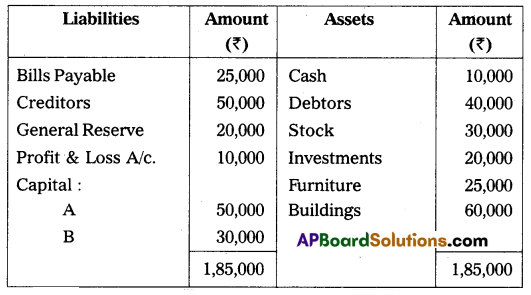
On 1st April 2016, they agreed to admit ‘C’ as a new partner for 1/5th share in profits on the following terms:
(1) ‘C’ should bring ₹ 40,000 for capital and ₹ 20,000 for goodwill in cash.
(2) Depreciate furniture by 10% and stock by 5%.
(3) Appreciate building value by 20%.
(4) Provide for bad debts at 5% on debtors.
Prepare necessary Ledger accounts and Balance Sheet of the new firm.
Answer:
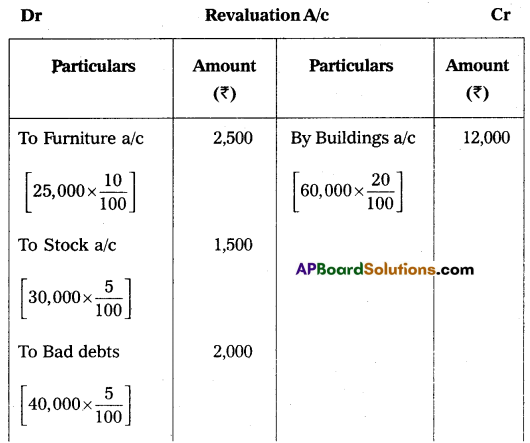

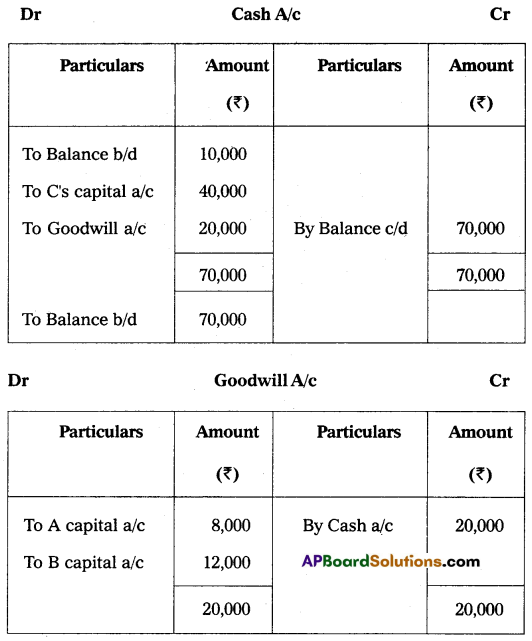
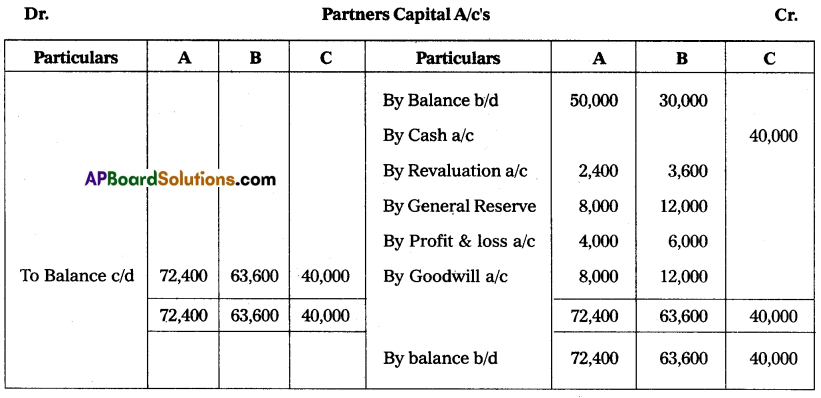
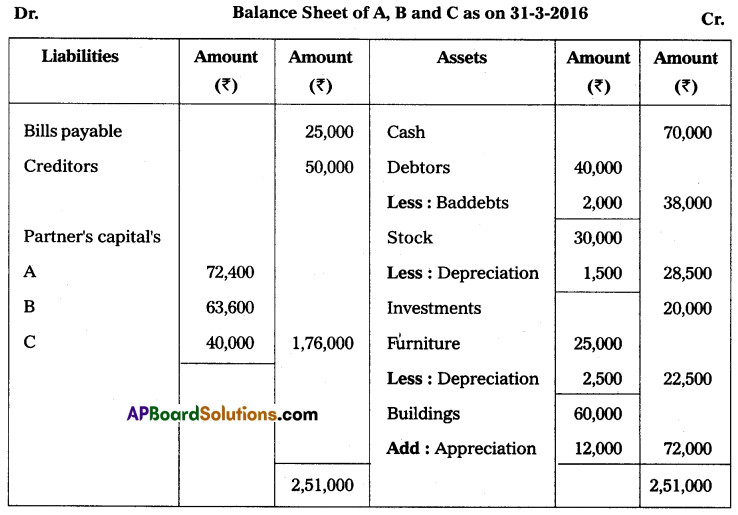
Section – E
(1 × 10 = 10)
Note: Answer any ONE of the following questions.
Question 19.
Radha of Haryana consigned 100 Radios to Balu of Hyderabad. The cost of each radio is ₹ 500. Radha paid insurance ₹ 500, and freight ₹ 800. Account sales were received from Balu showing the sale of 80 Radios at ₹ 600 each.
The following expenses were deducted by Balu:
Selling Expenses – ₹ 150.
Commission – 10% on Sales.
Radha received a bank draft for the balance due. Prepare important ledger accounts in the books of Radha.
Answer:



![]()
Question 20.
From the following Receipts and Payments Account, prepare the Income and Expenditure Account for the year ended 31-03-2017.
Receipts and payments Account for the year ended 31-03-2017.


Additional Information:
(1) Outstanding subscriptions as of 31-03-2017 – ₹ 1,500.
(2) Subscriptions received in Advance as of 31-03-2017 – ₹ 500.
(3) The value of old furniture sold is ₹ 45,000.
Answer:
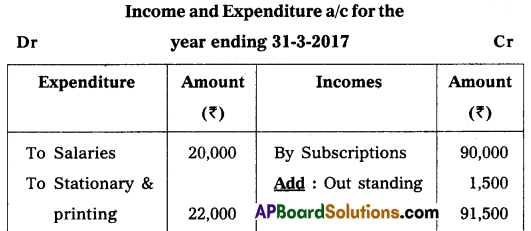
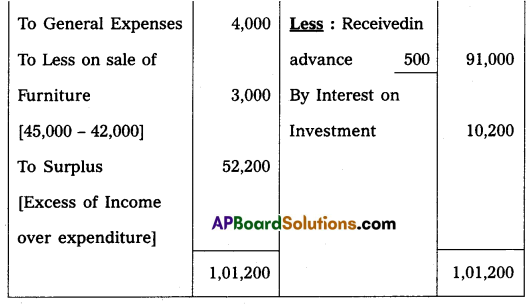
Section – F
(2 × 5 = 10)
Note: Answer any TWO of the following questions.
Question 21.
Write the features of the Receipts and Payments Account.
Answer:
Features:
- Receipts and payment accounts are similar to cash books.
- It is a real account.
- This account reveals opening and closing balances of cash and bank.
- It is maintained and the cash basis of accounting.
- Credit transactions are not recorded in receipts and payment accounts.
- All cash receipts are shown on the debit side, and all cash payments are shown on the credit side of the account.
- This account depicts the closing balance of cash and bank at the end of the year.
Question 22.
Ravi bought a Plant and Machine on 1st April 2009 for ₹ 28,000 and paid ₹ 2,000 for its installation. Depreciation is provided @ 10% under the straight-line method. On 31st March, 2012 the Plant was sold for ₹ 10,000. Prepare Plant and Machine accounts. Assuming that accounts are closed on 31st March every year.
Answer:
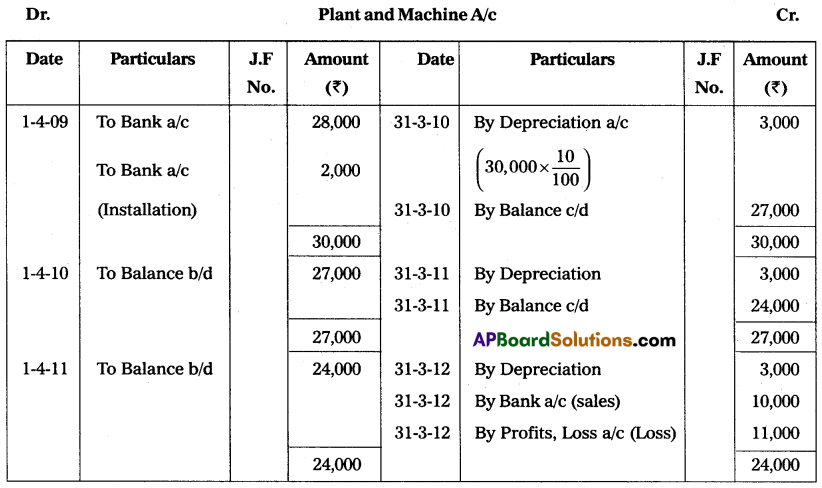
Question 23.
Calculate the Profit/Loss earned by Ramu who keeps his books under the Single Entry System.
Capital as on 01-04-2016 – ₹ 10,000
Fresh capital introduced – ₹ 5,000
Drawings during the year – ₹ 4,000
Capital as on 31-03-2017 – ₹ 25,000
Answer:
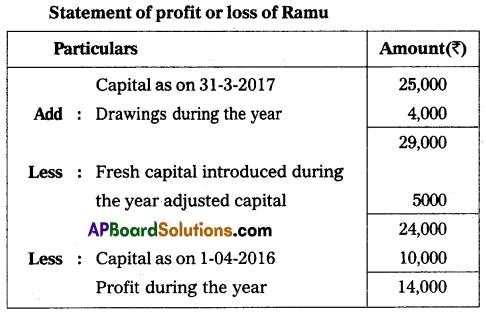
Question 24.
Explain any five features of Computerised Accounting.
Answer:
Computerized accounting is nothing but replacing the manual accounting system of maintaining the books of account with the use of relevant software packages for accounting computers. “As its name suggests “Computerised Accounting” is an accounting done with the support of a computer. It tends to involve dedicated accounting software and digital spreadsheets to keep track of a business or client’s financial transactions. Features of computerized accounting are:
- Fast, powerful, simple, and integrated: Computerised accounting is developed to automate and integrate all accounting transactions. All the accounting information that is recorded will be at the fingertips of the user. It is very simple to operate with a greater speed.
- Total visibility: The company will have greater visibility into the day-to-day business operations.
- Improved user-free experience: Computerised accounting permits the company to enter data in various ways. It makes the work a pleasure. The company can adopt specific company needs with this feature.
- Accuracy and error-free: Computerised accounting provides users with definable templates with which they can get accurate and error-free data within no time as and when the button is clicked by the user.
- Scalability: Computerised accounting is designed to meet the current and future needs of the companies irrespective of their size and style.
- Supremacy: Computerised accounting is capable of storing huge volumes of transactions with greater retrieval capacity and efficiency.
- Improved business performance: Integrated and enhanced features of computerized accounting cover accounting inventory, and reporting.
- Rapid decision making: Critical management information system reports instantly to make appropriate decisions at the right time.
- Absolute reliability: Computerised accounting provides accurate critical financial information.
Section – G
(5 × 2 = 10)
Note: Answer any FIVE of the following questions not exceeding 5 lines.
Question 25.
What is Obsolescence?
Answer:
Diminution (reduction) in the value of fixed assets due to new inventions, new improvements, changes in fashions, and changes in customers’ tastes and preferences.
Question 26.
Define Single Entry System of Book Keeping.
Answer:
The system which does not follow the rule of a double entry system is called a “single entry system”.
- Single entry is a simple method of recording business transactions.
- Profit or loss can be easily ascertained by comparing the opening capital with the closing capital.
- For keeping records in a single entry one does not require expert knowledge.
- No principles are required in this system.
Question 27.
What is the Delcredere Commission?
Answer:
Remuneration or additional commision paid to the consignee for taking the responsibility of collecting the amount on credit sales made by him.
Question 28.
What is Legacy?
Answer:
Legacy is the amount received by the organization as per the “will” of a person.
Question 29.
What is a Revaluation Account?
Answer:
An account prepared with the specific purpose of recording changes in the value of assets and liabilities of a partnership firm. It is called a Revaluation account.
Question 30.
M and N are partners sharing profits and losses equally. They decided to admit ‘P’ for 1/5th share of profits in the business. Calculate the new Sharing Ratio of M, N, and P.
Answer:
The old Ratio of M & N is 1 : 1
Take the total profits of the firm as 1
New partner ‘P’s share = \(\frac{1}{5}\)
Remaining share = 1 – \(\frac{1}{5}\) = \(\frac{4}{5}\)
New Ratio of M = \(\frac{4}{5}\) × \(\frac{1}{2}\) = \(\frac{4}{10}\)
New Ratio of N = \(\frac{4}{5}\) × \(\frac{1}{2}\) = \(\frac{4}{10}\)
New Ratio of P = \(\frac{1}{5}\) × \(\frac{2}{2}\) = \(\frac{2}{10}\)
∴ New Ratio of M, N & P = \(\frac{4}{10}: \frac{4}{10}: \frac{2}{10}\) = 4 : 4 : 2 = 2 : 2 : 1
![]()
Question 31.
What is Sage?
Answer:
Sage is useful online accounting software available to make accounting and billing operations on the web. Sage offers a simple, cost-effective web-based invoicing and accounting solution for startups and small businesses. It will be accessed at any time.
Question 32.
What is Marg?
Answer:
Marg was launched in 1992 by Computer Software Private Ltd., This software provides customized solutions depending upon the needs of each industry like pharmaceuticals, trading real industry, etc.